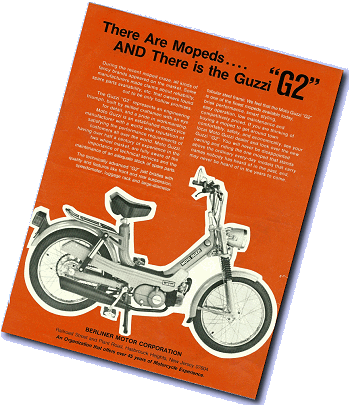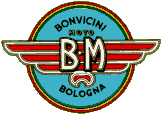
The logo says B M for Bonvicini Marino, and though few people in the UK may have any recognition of the brand, the company was quite long lived, and manufactured significant volumes of machines. Examples of this make are much more commonly encountered on the continent since the business never exported to Britain.
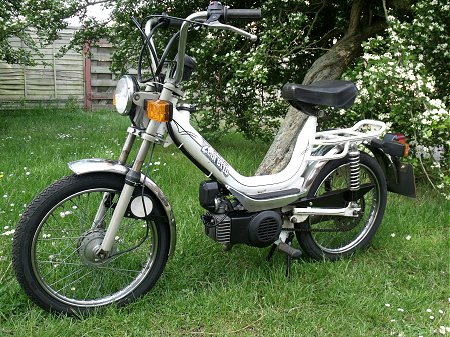
The company was established at Bologna in 1950, founded and directed by Mario Bonvicini, and began manufacturing light motor cycles fitted with Jlo 125ccand 169cc engines.
As BM engaged in a trading relationship with Bologna frame maker Verlicchi, a number of four-stroke light motor cycles up to a 250cc overhead camshaft twin were added to the range from 1953 but, more significantly for the long term, the company also began manufacturing a few early mopeds. It quickly became obvious that the popularity of mopeds was going to be far greater than the lesser demand for motor cycles so, by 1956, BM had begun phasing away its larger capacity machines to concentrate on moped production, supported by some small scooters and light motor cycles.
BM mopeds were largely assembled from locally sourced proprietary parts since many of the primary components were readily available in Bologna, with frames and some cycle parts supplied by Verlicchi, and engines from Franco Morini and Minarelli.
Many BM models were complemented with vivid and exotic names, the Dai-Dai, Jaguarino, Cross and Cross Special, Super Competition, Sport, Gambalesta, Wally, and Zebretta.
BM’s moped trade remained quite healthy right through the 1960s & ’70s with ranges of popular commuter and sports models fitted with Morini Franco and Minarelli six-speed engines, while Zebretta models were further being sold in the USA branded as the Baretta 44.
By the 1980s the company was more commonly going by the name of Moto BM, however, the general motor cycle trade was suffering a significant drop in business, and even Italian moped sales were dramatically falling away. Production was cut back to just a few models in an effort to make it through to a return of better times … but better times never came …
Moto BM filed for bankruptcy in 1988, the business was wound up, with its equipment and remaining assets being purchased by MZ. The final factory stock of some 100 Moto BM Zebrettas was offered to MZ agents at a knockdown price, and purchased by Wilf Green, an MZ dealership in Yorkshire–so it came to be that the very last BM machines were now poised to be sold off in a country that, ironically, had never imported the brand in the 38 years that the make had been in manufacture.
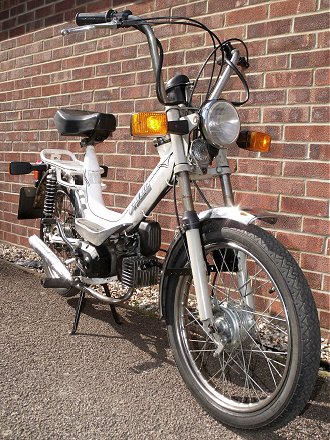
When it came to registering the bikes in Britain, the authorities had no reference to the now defunct Moto BM so some became recorded as MZ Zebrettas, while others were left to the whims of the respective Local Vehicle Licensing Offices.
You can just imagine a Zebretta in for first registration and the clerk looking down their makers lists … ‘Moto BM? No, don’t seem to have that here? What’s the nearest name to it? That’ll do’.
Yes—our example was actually registered as a Moto Guzzi! (Don’t worry; we made a point of getting that corrected).
Before taking our test bike out for a ride, we’ll have our usual look round to take stock of what we’ve got.
Registered in 1990, our Zebretta falls well within the slo-ped age, has a kick-starter and footrests instead of pedals, and wears a ‘restricted to 30mph’ slo-ped plate on the steering headstock, which indicates manufacturer Moto BM SpA Pianoro, Bologna, Italy, and weight as 44kg (7 stone).
Topped by a pair of stainless steel mudguards, the wheels & tyres are 2.25×16, so this is quite a physically small moped, with just a 42-inch wheelbase. The characteristic Verlicchi spine frame comprises of a single 70mm diameter tube, which also forms the petrol tank, with swing arm rear suspension and exposed spring shocks, and telescopic fork set up front, though these are only basic suspension sets at both ends, simply sprung with no hydraulic damping.
It’s worth noting a bleed button at the rear of the frame/tank just underneath the seat for when you’re refuelling—press the button to vent the back of the frame when filling, or it’ll airlock and won’t hold full capacity. It’s surprising how quickly the tank overflows when you’re topping it up (yes, we found out the hard way), so the bleed button is certainly not there as an ornament.
The saddle is moulded foam and feels reasonably comfortable, but the tank-in-frame design doesn’t accommodate any saddle stem other than a fixed mounting peg for the clamp fitting, which means the 31-inch seat height isn’t adjustable, so one size fits all—though probably not so well for taller people!
Due to the short frame, small wheels, and outboard mounting arrangement of the rear shocks, the back of the bike manages to convey a stout and sturdy expression, and some expectation of a positive ride.
The undamped front forks are a conventional ‘grease’ set, but do seem a little odd in grey finish, contrasting with the white frame … has someone replaced them? We do a bit of research, and no, that really is the correct and original colour, though does seem a somewhat unusual choice.
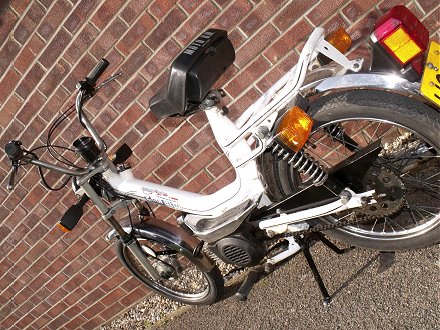
The forks are topped with a CEV 40mph speedometer, centrally mounted above the top yoke so the drive cable descends through the steering stem.
Lighting, switchgear and horn are CEV components and, despite having no battery, the 6-Volt AC system drives a full indicator set, worked from a switch on the left bar: left–off–right.
The right switch set has horn, cut-out, and beam–off–dip. Electrical cables running from both brake lever brackets indicate a brake lighting circuit, which is powered from a tap off the HT coil, so it’s important to maintain a correct and suitably rated bulb in the stop lamp (6-Volt × 8-Watt), or the engine can cut out on tick-over when a brake is applied.
Above the engine there are chrome plated footplates with moulded mats to satisfy the strange continental feet-up riding style, though quite why anyone might want to do that on a ‘footrest’ moped is something of a mystery?
Zebretta is fitted with a Minarelli V1 automatic engine, which we’ve encountered previously on a Kestrel test, and were quite impressed at what a gutsy little motor this proved to be, so maybe we’re hopeful it may prove a little better than the regulation plate suggests? V1 has a forced-air, fan-cooled, cast iron cylinder, though air-cooled alloy cylinder head, and ample finning on both so it really shouldn’t overheat under any conditions.
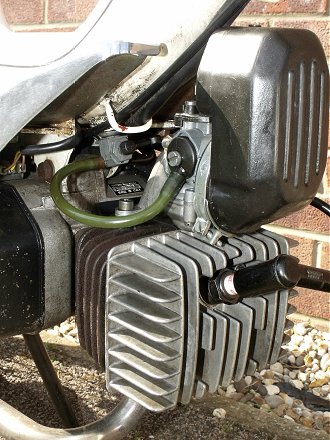
The horizontal engine layout neatly arranges the forward facing Dell’orto 12/14 carburetter above the cylinder, to fill the angular space as the main frame tube rises to the headset: a tidy design—except the fuel tap is mounted at the bottom of the frame behind the carburetter manifold and underneath the footplates. This has to be one of the most inaccessible fuel taps we’ve ever come across! You can just about see it from the front right-hand side of the bike by bending down and looking into its cave. You certainly won’t be able to reach the tap lever with gloves on, and it’s just the sort of area on a moped that’s bound to get all dirty and oily, so the tap is probably likely to always be left ‘on’—and just hope the carburetter doesn’t flood too much.
Location of Zebretta’s fuel tap is certainly a classic masterpiece of bad design!
Click on the choke lever at the carburetter, which will automatically release when the throttle is opened fully. There’s no key switch, so seemingly just kick to go, however the kick-start swings through a learning curve … which means the first time you try to kick-start normally with your instep, you’ll bust your toes on the footrest! Arghh! We won’t be doing that again! Now you’re learning to kick-start with the ball of your foot.
Fortunately our V1 rocket motor fires up quite readily, so we don’t have to be playing the dance of death with the kick-starter any more. The motor readily asks to clear the choke (we later discover the bike will usually start OK without even requiring any choke), and quickly settles down to a regular tick over. The exhaust tone is crisp and tinny with good response to the throttle, so this engine seems smart and sharp.
Nudge off the stand and throttle away, response is very good right from the off, acceleration is strong and rapid and there’s an immediate impression of what a great little engine the automatic Minarelli V1 really is.
There’s also an immediate impression as to what a poor speedometer this CEV is, as the needle swings wildly around the dial, commonly bouncing over a 10mph range, while the instrument freely rotates within in the housing, clockwise or anticlockwise according to the changing vibration frequency of the rising motor revs. A brief exchange with our pace rider quickly establishes that even any guesstimated indications from our speedometer are going to be wholly meaningless, so the whole test will have to rely completely on pace readings.
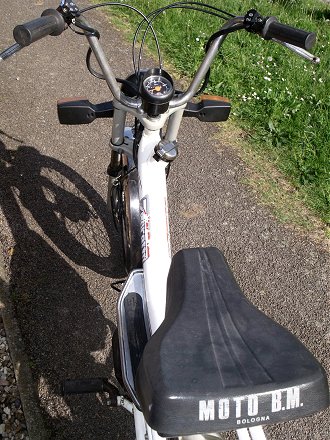
A light uphill climb out of the village is capably despatched, though there’s getting to be some feeling that the Zebretta is probably only going to perform pretty much up to its specified design speed due to having a low final drive ratio. We pull up to investigate the sprockets, and that front sprocket does look pretty small … scratch a mark on a tooth and count … just 10 teeth; yeah, that sure is small.
It looks as if the V1 engine is limited to 30mph performance by fitting low gearing, which explains the excellent acceleration and hill climbing abilities, but an engine can easily rev itself to an early grave on a low drive ratio like that.
Continuing our run at a busily revving 28mph cruising speed, we work some heat into the motor for our best on flat speed, in crouch position: 32mph. Our shrieking downhill run demonstrates that the V1 motor is capable of revs you may only ordinarily expect from an electric motor, with the pace bike clocking us at 38mph through the dip, before charging the following climb. V1 digs in for tackling the hill as you hear the exhaust tone smooth out under load and the motor pulls strong and clean, to confidently crest the rise at 27mph—easily up to the task.
The suspension rode well, handling was good, cornering confident, brakes effective, seat was comfortable … though we weren’t overly keen on the feel of the ‘cruiser-style’ pull-back handlebars, but a very efficient and capable machine.
It seemed unfortunate that the excellent Minarelli V1 engine had been so dramatically under geared for the bike to meet compliance with the 30mph restricted ‘slo-ped’ specification, and we wondered what it might be like geared up a little?
Oh look! The workshop has found a compatible 15mm bore × 10mm flats × 12-tooth front sprocket, and following a quick pit stop, we’re ready for a re-run with a 20% higher drive ratio!
Pulling away from a standstill this time, the snappy initial acceleration is markedly reduced, and the automatic clutch very noticeably has to do some work now, though it doesn’t appear much different from how many other automatic mopeds pull away. Appreciating there are no pedals for rider assistance on modern mopeds, we wonder how Zebretta might manage a hill start now?
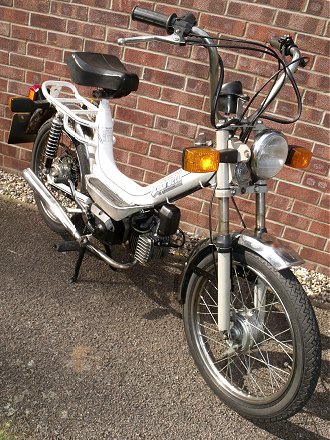
The Minarelli motor doggedly keeps at the task and soon works through the initial phase, the clutch bites fully in around 10mph, the engine pulls hard and seems largely un-fazed by the increased gearing as the revs pick up and V1 climbs into the power band.
The V1 motor does feel to be quite happy when pulling under load, particularly when going uphill, so copes with our radical gear-up pretty well. The initial acceleration is now replaced by a strong surge further up the range. First impression is that the bike is certainly going faster now, the revs are down, but the speed is up, and even our animated and melodramatic CEV speedometer clearly has its needle pushed further round the dial already.
Zebretta now seems to cruise comfortably at full speed since the revs are lower. Our pace bike subsequently reads best on flat 37mph, downhill run 41mph, and we charge the uphill section with all our worth, expecting the gearing increase to cause the speed to fall away—not so! The Minarelli V1 enthusiastically takes up the challenge and absolutely storms the hill to crest the rise at 29mph!
We’ve increased the drive ratio and it goes uphill even faster—what an incredible little motor!
Doing a bit of maths here, we geared up 20%, and on-flat performance increased by 15%. The motor is not pulling the same revs, but is much more contented to ride and doesn’t feel to be revving itself to death any more.
The downhill run performance only increased by 8%, and this time the motor wasn’t screaming out, so that’s an improvement too. We figure a longer downhill run would almost certainly have allowed more speed to build up, but we’re happy enough with the general result, which is an adequate illustration.
Most surprisingly, the uphill performance improved by 7%, which serves as a reasonable indication that the new drive ratio is still within the engine’s capability.
The historical practice of some manufacturers in the ’70s and ’80s of gearing down drive ratios to make bikes compliant with 50cc ‘slo-ped’ legislation for some markets demanding 30mph speed limitations from 1976, was really bad news for motors of the time, which were almost certain to suffer premature failure from constant over-revving in use.
Our objective test exercise illustrates the effect of such a simple change to return our Zebretta’s running ratio from ‘restricted’ to ‘normal’, and there were certainly a number of machines of the period that employed drive ratio reductions to meet restricted market compliance.
Today, many ‘slo-ped’ compliant 50s are invariably designed with other limiting factors that allow more effective performance within the specified range, but limit the maximum top speed by other means.


